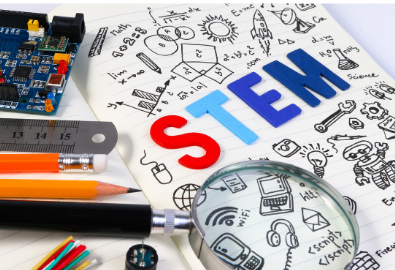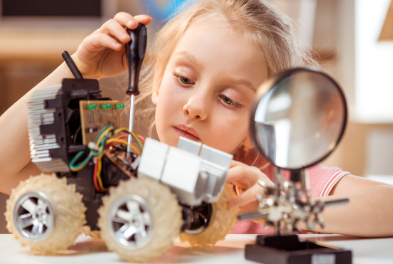by Mary Adams, AWC The Hague
Education team member Mary Adams sat down with Lori Gatmaitan, Director of the SAE Foundation, to discuss her educational programs and opinions about Inspiring Curiosity in STEM. The mission of the SAE Foundation is to increase student achievement and participation in science, technology, engineering and math to build a STEM-fluent workforce.
What is it about STEM that inspired your own curiosity?
 I grew up in a family where neither of my parents had an opportunity to attend college. My mom grew up in Germany during WWII and dropped out of high school to help care for her family. My father worked on the manufacturing line at General Motors (GM) in Flint after the army. My dad was a very resourceful man. If something needed to be fixed or made better, he could do it. If he had had a chance to go to college, it likely would have been for engineering. Ultimately my STEM influence was my oldest sister, who pursued an engineering degree at Kettering University. I was intrigued by the co-op program there and knew that I liked math and science, so I followed in her footsteps.
I grew up in a family where neither of my parents had an opportunity to attend college. My mom grew up in Germany during WWII and dropped out of high school to help care for her family. My father worked on the manufacturing line at General Motors (GM) in Flint after the army. My dad was a very resourceful man. If something needed to be fixed or made better, he could do it. If he had had a chance to go to college, it likely would have been for engineering. Ultimately my STEM influence was my oldest sister, who pursued an engineering degree at Kettering University. I was intrigued by the co-op program there and knew that I liked math and science, so I followed in her footsteps.
What was the male-female ratio at Kettering University when you attended?
If I can recall correctly, it was about 17:1 in favor of males. As a freshman, I had a professor who was very focused on male students and didn’t pay much attention to the three women in his class. This type of behavior was rare, but still as a young woman, you wonder what is happening. Even today, women make up only about 28% of the science and engineering workforce. In some areas we are making changes, like in the social and biological studies, but overall, if you look at the total gender landscape across all STEM areas, are we really progressing? Racial and ethnic minority groups are significantly underrepresented for both men and women in STEM degrees and professions. Even if girls enter STEM programming, do they complete the program? Once they get a job, do they stay in an engineering career? Women leave STEM careers at disproportionately higher rates than men for various reasons, but they often experience isolation caused by lack of access to women peers, role models and mentors.
Do you see female stereotyping in STEM?
What we know is that girls are as equally interested in math and science as boys at young ages. We also know that achievement levels for girls are equal to or higher in math and science. So what is holding more girls back from pursuing a STEM degree and career as they age? Teachers can play a significant role in influencing or dispelling stereotypes in STEM education. Awareness and access are critical.
How can parents help their children in STEM?
Exposure to math and science at an early age is a positive influence, especially when you can bring parents on board for the journey. When a family cultivates an interest in math and science in their children, this translates to their school achievements and scores. When children are excited about something and have parental support, they do really well and even seek out opportunities on their own.
What is A World in Motion?
 The SAE Foundation pre-K–8 STEM education program is called A World in Motion (AWIM). The program is a hands-on, inquiry-based learning experience that brings science, technology, engineering and math concepts to life. We are not trying to create the next army of engineers, but we are trying to give children an appetite and a competency in math and science. Research shows that if a child does not have a feeling of competency by age eight (3rd grade), they stop considering STEM as an education option. For girls, it's very important that they feel competent. If not, when STEM opportunities appear, they shy away from them because they think, “Oh, you have to be good in math. Forget it. I am not going to do it because I am not good at math.” We want them to say, “Yes, I want to learn more about that!”
The SAE Foundation pre-K–8 STEM education program is called A World in Motion (AWIM). The program is a hands-on, inquiry-based learning experience that brings science, technology, engineering and math concepts to life. We are not trying to create the next army of engineers, but we are trying to give children an appetite and a competency in math and science. Research shows that if a child does not have a feeling of competency by age eight (3rd grade), they stop considering STEM as an education option. For girls, it's very important that they feel competent. If not, when STEM opportunities appear, they shy away from them because they think, “Oh, you have to be good in math. Forget it. I am not going to do it because I am not good at math.” We want them to say, “Yes, I want to learn more about that!”
Does being tech savvy at an early age mean a positive attitude towards engineering?
Yes and no. Devices and games make technology less scary and more interesting for children. The flipside is that the critical thinking and hands-on piece is missing. We designed the SAE Programming Each Other class to be completely unplugged. Kids are not programming on a device. They are thinking through the logic steps and problem-solving with materials that are not necessarily all on a computer. This enhances critical thinking and teaches them how to think holistically about a problem and work as a team.
How important is career visualization at an early age?
Many children don’t know what engineers do. If they grew up with Thomas the Train, then they think that engineers drive trains. Many think of Albert Einstein when conjuring up a scientist. Many adults when asked to name a famous scientist would have trouble naming a female. There are very few examples of diverse female engineers and scientists portrayed to students. Developing the right image is really important in order to shift children’s mindsets. Portraying women's achievements in these subjects can shift perceptions about who belongs. SAE’s AWIM LearnTwice is a program that places university and high school students in elementary classrooms as volunteers and mentors. Children can see that engineers can be male, female or a minority. This breaks the myth that engineers are old, stodgy men with nerdy glasses and pocket protectors. It allows them to see someone who may look like them doing fun and cool things with STEM.
Any challenges?
Our programs might replace some of the usual curriculum that teachers develop. For teachers who do not have math or science backgrounds it can be overwhelming. Teachers who use the same curriculum over many years are often resistant to change. We can’t blame them for that. Teaching is hard, especially now in the pandemic environment. It means a systemic shift in the entire education system. We need a long-term strategic view to invest in STEM for three-year olds. That takes patience and funding commitment, but creating a stronger socio-economic society is an excellent return on investment.
Any advice for our readers?
Girls are always looking to see how they can make a difference. We need to start showing them how that is possible within STEM. There was a study from the National Academy of Engineering that asked students if they wanted to be engineers; girls were twice as likely as boys to say no. But when asked if they would like to design a safe water system, save the reainforest or use DNS to solve crimes, the girls answered yes. We need to let them know that is okay to be good in math and science. STEM is a building block. Even though I am not an engineer anymore, my education in engineering definitely helped me get to where I am and gave me the transferrable skills allow me to be successful. STEM is fun...and can change the world!
Photos: Canva


